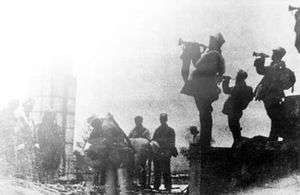Siege of Changchun
| Siege of Changchun | |||||||
|---|---|---|---|---|---|---|---|
| Part of the Chinese Civil War | |||||||
 Changchun after the siege | |||||||
| |||||||
| Belligerents | |||||||
|
|
| ||||||
| Commanders and leaders | |||||||
|
|
| ||||||
| Strength | |||||||
| ~100,000 | 100,000 | ||||||
| Casualties and losses | |||||||
| 95,000; ~330,000 civilian deaths [1] | minimal | ||||||
The Siege of Changchun (simplified Chinese: 长春围困战; traditional Chinese: 長春圍困戰; pinyin: Chángchūn Wéikùnzhàn) was a siege operation launched by the People's Liberation Army during the Chinese Civil War against the city of Changchun, defended by the Nationalist forces. The Siege of Changchun was part of the Liaoshen Campaign, and the fall of Changchun marked the end of its first stage.
Beginning on May 23, 1948, the People's Liberation Army began to encircle the Nationalist defenders in Changchun, while cutting off air transportation. The siege would last for 150 days, and resulted in the deaths from starvation of an estimated 80 percent of the civilian population.[2] The siege ended when the People's Liberation Army entered Changchun after the Nationalist 60th Army and New 7th Army surrendered.
Lin Biao commanded the Communist forces during the siege. Lin had initially proposed to move on Changchun in April, but turned his attention to other cities after investigating Changchun. In October, Lin proposed to finally take the city. In response, Mao Zedong sent a sarcastic telegram ridiculing him for not having taken the city five months prior, and ordering Lin to take Jinzhou instead.[3] As news from Jinzhou reached Changchun, the KMT commanding general, Ceng Zesheng (Chinese: 曾澤生; pinyin: Céng Zéshēng), defected to the Communists along with most of his officers. They were given posts in the Communist armies on Mao's personal orders.[4]
Civilian starvation
Large numbers of civilians starved in the siege; estimates range from 150,000[5] to 330,000.[1] The besieging Communist forces allowed Nationalist soldiers to leave, but forcibly prevented civilians from doing so, hoping to pressure General Zheng Dongguo (Chinese: 鄭洞國; pinyin: Zhèng Dòngguó), leader of the Nationalist forces, into surrender. Only 40,000 survivors remained, to tell of eating "rotten sorghum, then corncobs and then the bark off the trees” Later, people opened their pillows and consumed the corn husk filling. Later still they boiled and ate leather.[2]
The incident was reported in a book published by the People's Liberation Army Publishing House in August 1989, two months after the Tiananmen Square incident. White Snow, Red Blood, by Lieutenant Colonel Zhang Zhenglu, stated that 150,000 civilians starved to death during the siege, and that civilians attempting to leave the city were turned back to put pressure on the KMT garrison's food supply. In poorer areas of the city, the members of 9 out of 10 families all died.[2] Lt. Col. Zhang opined that the Chinese Revolution was "not worth the cost", and praised Lin Biao's military skills as "superior to Mao Zedong's".[5]
See also
- List of Battles of Chinese Civil War
- National Revolutionary Army
- History of the People's Liberation Army
- Chinese Civil War
Notes
- 1 2 Chang, Jung; Halliday, Jon. 2006. Mao: The Unknown Story. London: Vintage Books. p383.
- 1 2 3 China Is Wordless on Traumas of Communists’ Rise, Andrew Jacobs, New York Times, 1 October 2009
- ↑ Westad, Odd Arne. Decisive encounters: the Chinese Civil War, 1946–1950. Stanford University Press, 2003. p. 194.
- ↑ Westad, p. 197.
- 1 2 Pomfret, John (2009-10-02). "Red Army Starved 150,000 Chinese Civilians, Books Says". Associated Press. The Seattle Times. Archived from the original on 2009-10-02. Retrieved 2009-10-02.